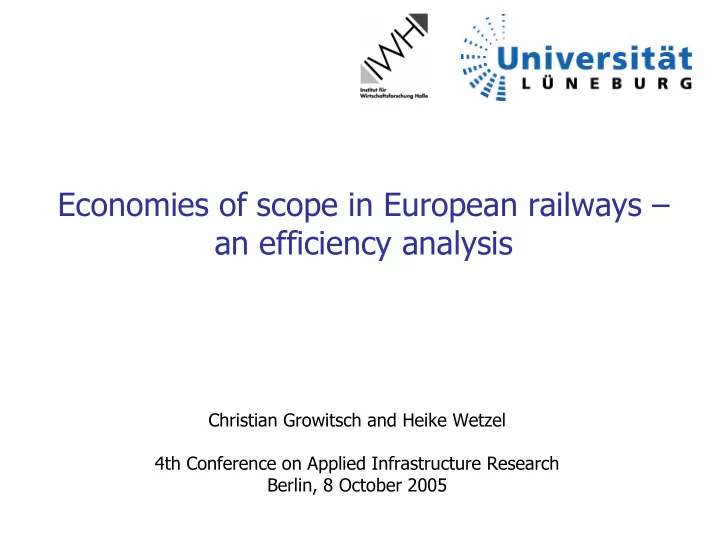

Economies of scope in European railways – an efficiency analysis Christian Growitsch and Heike Wetzel 4th Conference on Applied Infrastructure Research Berlin, 8 October 2005
1. introduction 2. theoretical background 3. data description 4. methodological approach 5. first stage results 6. second stage results 2
European regulation and sector structure infrastructure 1 introduction vertical economies of scope? horizontal passenger freight economies of service service scope? European regulation: Do economies of scope � accounting separation militate � organizational separation against separation? � (institutional separation) 3
economies of scope 2 theoretical background cost information available: � comparison of cost of joint production and separate production m m ∑ ∑ < i i C ( Y ) C ( Y ) = = i 1 i 1 no cost information: � comparison of technical efficiency of joint production and separate production efficiency of joint efficiency of separate > production production 4
data � cross-country data: 23 European countries 3 data description � years of observation: 2000, 2001, 2002, 2003, 2004 number of company structure observations firms integrated company (IC) 22 73 infrastructure manager (IM) 10 33 (23) passenger operator (PO) 4 (15) 16 (28) freight operator (FO) 8 14 (16) passenger and freight operator (RU) 5 15 total 49 (60) 151 (155) 5
variables first stage input–output variables: 3 data description transport operator infrastructure integrated company manager (passenger/ freight) inputs outputs inputs outputs inputs outputs employees train-km employees train-km employees rolling stock pass.-km (opex) rolling stock pass.-km (opex) (opex) freight network freight ton-km length ton-km network length 6
data envelopment analysis 4 methodological approach production technology � input distance function � constant returns to scale D I (x,y)=max { θ :(x/ θ ) є L(y)} technical efficiency: [D I (x,y)] -1 = min θ x 1 / y s x s.t. - y i + Y λ ≥ 0 θ x i – X λ ≥ 0 x/ θ λ ≥ 0 s´ 0 x 2 / y 7
testing for economies of scope 4 methodological approach comparision of efficiency between separate production (S A+ B ) and joint production (S AB ) x 1 / y super efficiency scores: S A S A+ B S B S AB min θ j * s.t. - y j + Y s λ s ≥ 0 , j є E AB θ j * x j – X s λ s ≥ 0 , s є E A+B λ s ≥ 0 0 x 2 / y source: Morita 2002 8
testing for economies of scope 4 methodological approach x 1 /y x 1 /y joint separate AB A+B joint separate AB A+B x 2 /y x 2 /y 0 0 economies of scope diseconomies of scope max { θ * AB }< 1 max { θ * A+B } < 1 9
testing for economies of scope 4 methodological approach partial economies and diseconomies of scope: x 1 /y economies of scope joint diseconomies AB of scope separate A+B x 2 /y 0 max { φ k AB } > 1, max { φ k A+B } > 1 10
efficiency scores: model 1 efficiency scores mean minimum maximum 5 first stage results integrated company (IC) 0,64 0,25 1,0 (11) network manager (IM) 0,51 0,13 1,0 (3) passenger operator (PO) 0,62 0,38 1,0 (2) freight operator (FO) 0,42 0,06 1,0 (2) passenger + freight operator (RU) 0,85 0,26 1,0 (3) � 3 IM x 2 PO x 2 FO + 3 IM x 3 RU = 21 virtually joint companies (VC) 0,96 0,93 1,0 (17) 11
super efficiency: model 1 5 first stage results joint production (efficient integrated companies): mean minimum maximum 1,88 0,64 2,86 separate production (efficient virtually joint companies): mean minimum maximum 13,99 1,57 27,35 � partial economies and diseconomies of scope 12
environmental influences 6 second stage results truncated regression: 1/TE crs Pure TE OPEX TE GDP per capita -0.0005 -0.0000 Network density -0.0801 -0.0047 Population density -0.0919 -0.0033 dummy PO 10.8241 3.6435 * dummy FO 29.7052 0.0949 dummy IM 21.6824 1.6438 dummy RU -48.6092 -0.9194 constant -16.1622 -1.3599 13
Recommend
More recommend